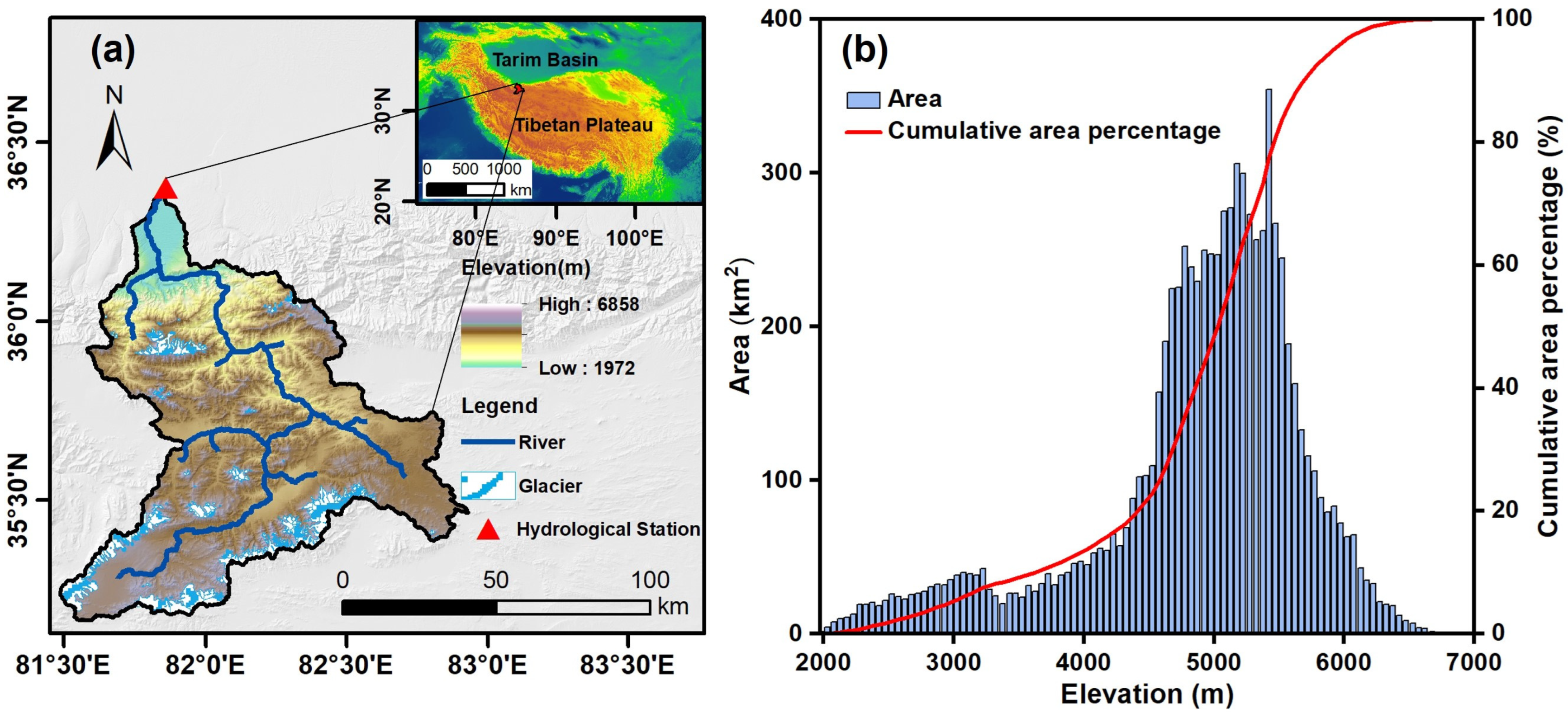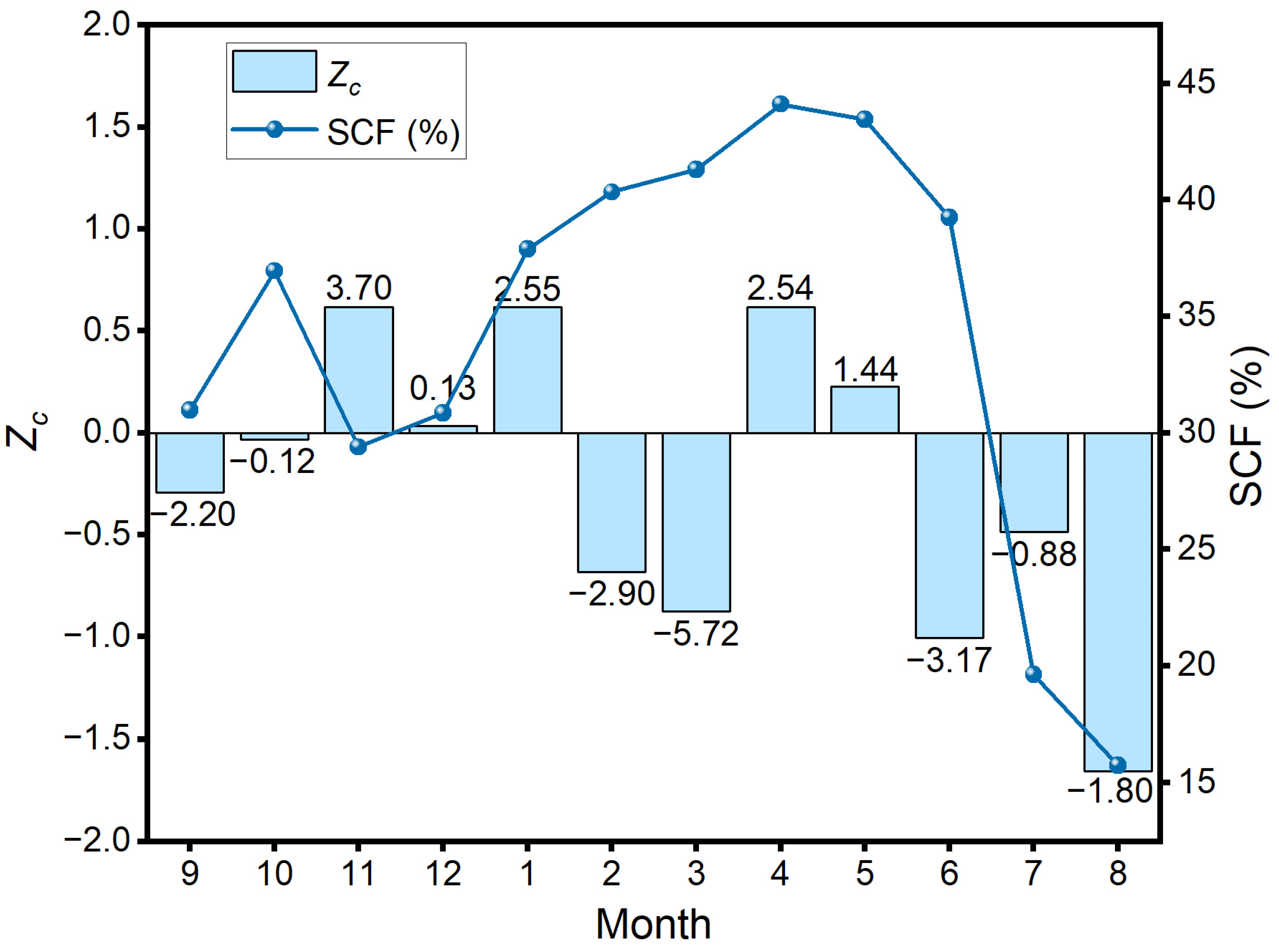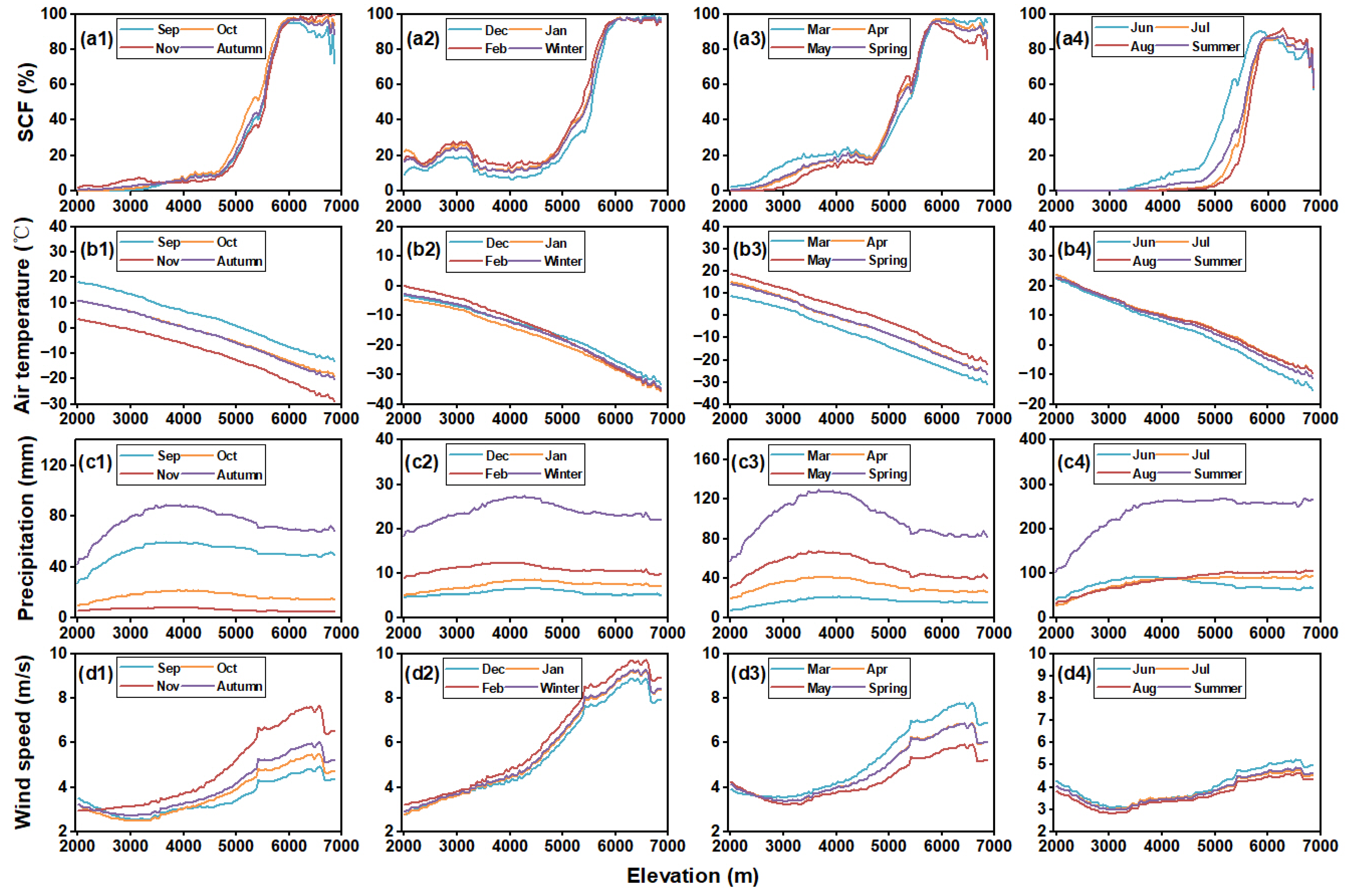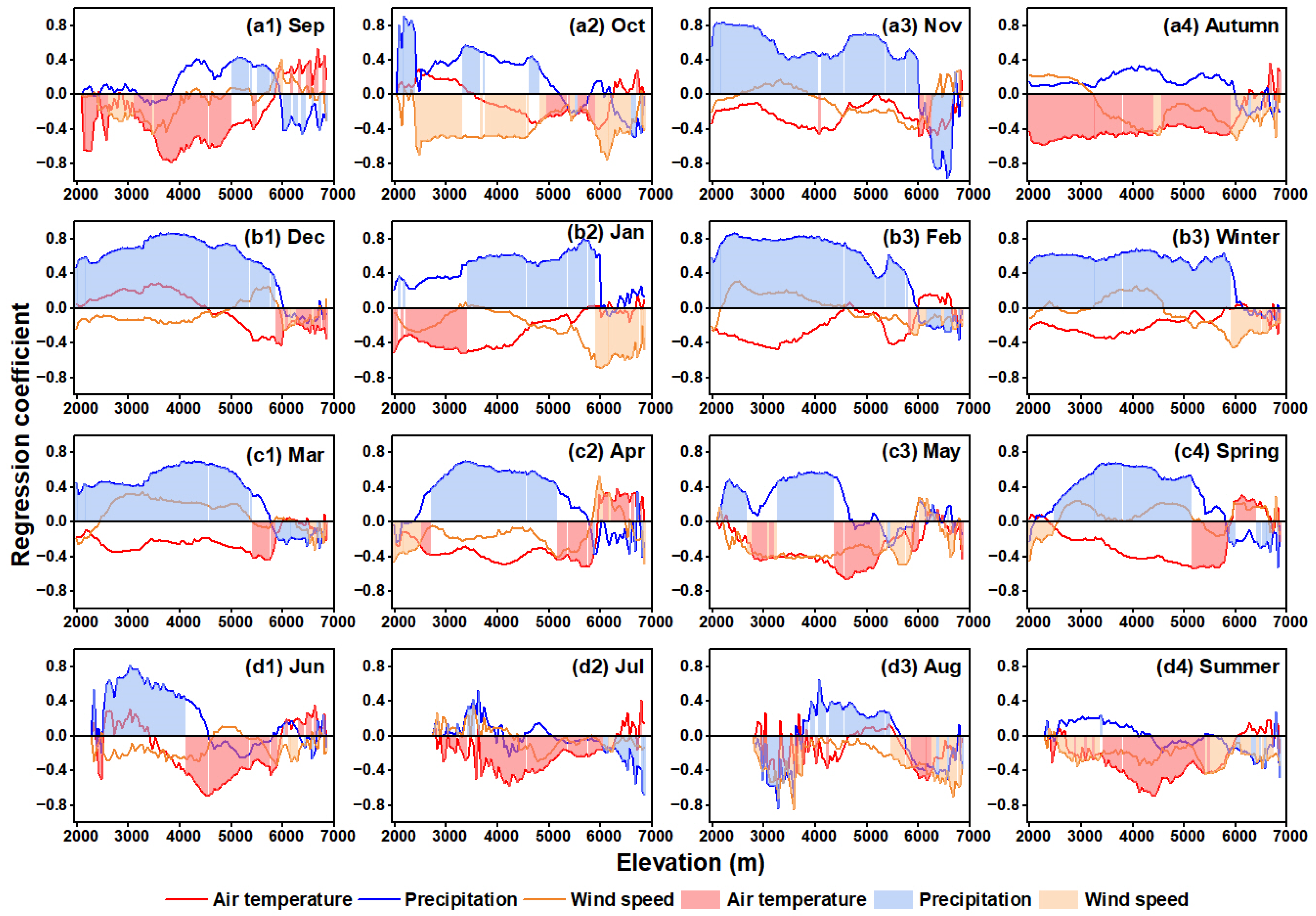What Is the Threshold Elevation at Which Climatic Factors Determine Snow Cover Variability? A Case Study of the Keriya River Basin
Abstract
:1. Introduction
2. Materials and Methods
2.1. Study Area
2.2. Data Sources
2.3. Methods
2.3.1. Snow Cover Frequency (SCF)
2.3.2. Sen’s Slope and Mann–Kendall Trend Test Methods
2.3.3. Partial Least Squares Regression (PLSR)
3. Results
3.1. Variation Characteristics of Snow Cover
3.2. Vertical Distribution Characteristics of Snow Cover and Climatic Factors
3.3. Vertical Distribution Characteristics of the Main Control Factors of SCF
4. Discussion
4.1. Compared with the Threshold Elevation of Previous Studies
4.2. Future Work
5. Conclusions
Author Contributions
Funding
Data Availability Statement
Acknowledgments
Conflicts of Interest
References
- Déry, S.J.; Brown, R.D. Recent Northern Hemisphere snow cover extent trends and implications for the snow-albedo feedback. Geophys. Res. Lett. 2007, 34, L22504. [Google Scholar] [CrossRef]
- Chen, X.; Yang, Y.; Ma, Y.; Li, H. Distribution and attribution of terrestrial snow cover phenology changes over the Northern Hemisphere during 2001–2020. Remote Sens. 2021, 13, 1843. [Google Scholar] [CrossRef]
- Brown, R.D.; Robinson, D.A. Northern Hemisphere spring snow cover variability and change over 1922–2010 including an assessment of uncertainty. Cryosphere 2011, 5, 219–229. [Google Scholar] [CrossRef]
- Shen, Y.; Su, H.; Wang, G.; Mao, W.; Wang, S.; Han, P.; Wang, N.; Li, Z. The responses of glaciers and snow cover to climate change in Xinjiang (I):Hydrological effects. J. Glaciol. Geocryol. 2013, 35, 513–527. [Google Scholar] [CrossRef]
- Yao, T.; Qin, D.; Shen, Y.; Zhao, L.; Wang, N.; Lu, A. Cryospheric changes and their impacts on regional water cycle and ecological conditions in the Qinghai-Tibetan Plateau. Chin. J. Nat. 2013, 35, 179–186. [Google Scholar] [CrossRef]
- Sood, V.; Singh, S.; Taloor, A.K.; Prashar, S.; Kaur, R. Monitoring and mapping of snow cover variability using topographically derived NDSI model over north Indian Himalayas during the period 2008–2019. Appl. Comput. Geosci. 2020, 8, 100040. [Google Scholar] [CrossRef]
- Yan, J.; Wei, R.; Wang, J.; Niu, J.; Ji, S.; Lu, S.; Li, X. Study on spatial-temporal varations of snow cover days and its indicating climatic significance in the Middle and Lower Reaches of Yangtze River for the past 50 years. J. Xinyang Norm. Univ. (Nat. Sci. Ed.) 2022, 35, 92–96. [Google Scholar] [CrossRef]
- Dong, C. Remote sensing, hydrological modeling and in situ observations in snow cover research: A review. J. Hydrol. 2018, 561, 573–583. [Google Scholar] [CrossRef]
- Tan, X.; Wu, Z.; Mu, X.; Gao, P.; Zhao, G.; Sun, W.; Gu, C. Spatiotemporal changes in snow cover over China during 1960–2013. Atmos. Res. 2019, 218, 183–194. [Google Scholar] [CrossRef]
- Chen, Y.; Zhang, X.; Fang, G.; Li, Z.; Wang, F.; Qin, J.; Sun, F. Potential risks and challenges of climate change in the arid region of northwestern China. Reg. Sustain. 2020, 1, 20–30. [Google Scholar] [CrossRef]
- Qin, D.; Yao, T.; Ding, Y.; Ren, J. Introduction to Cryospheric Science; Springer Geography: Beijing, China, 2021. [Google Scholar]
- Rupp, D.E.; Mote, P.W.; Bindoff, N.L.; Stott, P.A.; Robinson, D.A. Detection and attribution of observed changes in Northern Hemisphere spring snow cover. J. Clim. 2013, 26, 6904–6914. [Google Scholar] [CrossRef]
- Qin, D.; Liu, S.; Li, P. Snow cover distribution, variability, and response to climate change in western China. J. Clim. 2006, 19, 1820–1833. [Google Scholar] [CrossRef]
- Dye, D.G.; Tucker, C.J. Seasonality and trends of snow-cover, vegetation index, and temperature in northern Eurasia. Geophys. Res. Lett. 2003, 30, 1405. [Google Scholar] [CrossRef]
- Shi, M.; Yuan, Z.; Hong, X.; Liu, S. Spatiotemporal Variation of Snow Cover and Its Response to Climate Change in the Source Region of the Yangtze River, China. Atmosphere 2022, 13, 1161. [Google Scholar] [CrossRef]
- Li, H.; Li, Z.; Chen, P.; Peng, J. Spatio-temporal variation of snow cover in Altai Mountains of Xinjiang in recent 20 years and its influencing factors. Arid. Zone Res. 2023, 40, 1040–1051. [Google Scholar] [CrossRef]
- Hammond, J.C.; Saavedra, F.A.; Kampf, S.K. Global snow zone maps and trends in snow persistence 2001–2016. Int. J. Climatol. 2018, 38, 4369–4383. [Google Scholar] [CrossRef]
- Yan, W.; Liu, J.; Luo, G.; Dong, K.; Lu, W.; Du, X. Snow cover area changes in the Yurungkax River Basin of West Kunlun Mountains during 2000–2013 using MODIS data. Prog. Geogr. 2014, 33, 315–325. [Google Scholar] [CrossRef]
- Gao, J.; Williams, M.W.; Fu, X.; Wang, G.; Gong, T. Spatiotemporal distribution of snow in eastern Tibet and the response to climate change. Remote Sens. Environ. 2012, 121, 1–9. [Google Scholar] [CrossRef]
- Liu, M.; Ma, J.; Wang, L.; Lu, S.; Yan, J.; Liu, J.; He, Z.; Cui, Y. Spatial and temporal varations of shallow ground temperature in the Huaihe River Source and its response to recent global warming hiatus. J. Xinyang Norm. Univ. (Nat. Sci. Ed.) 2023, 36, 180–185. [Google Scholar] [CrossRef]
- He, Y.; Wang, K. Contrast patterns and trends of lapse rates calculated from near-surface air and land surface temperatures in China from 1961 to 2014. Sci. Bull. 2020, 65, 1217–1224. [Google Scholar] [CrossRef]
- Noad, N.C.; Bonnaventure, P.P.; Gilson, G.F.; Jiskoot, H.; Garibaldi, M.C. Surface-based temperature inversion characteristics and impact on surface air temperatures in northwestern Canada from radiosonde data between 1990 and 2016. Arct. Sci. 2023, 9, 545–563. [Google Scholar] [CrossRef]
- Zhao, G.; Han, Y.; Liu, W.; Zhang, R.; Meng, J.; Zeng, X. Spatial-temporal variations of extreme temperature events in Xinjiang from 1961 to 2016. J. Xinyang Norm. Univ. (Nat. Sci. Ed.) 2021, 34, 248–254. [Google Scholar] [CrossRef]
- Ménégoz, M.; Valla, E.; Jourdain, N.C.; Blanchet, J.; Beaumet, J.; Wilhelm, B.; Gallée, H.; Fettweis, X.; Morin, S.; Anquetin, S. Contrasting seasonal changes in total and intense precipitation in the European Alps from 1903 to 2010. Hydrol. Earth Syst. Sci. 2020, 24, 5355–5377. [Google Scholar] [CrossRef]
- Luo, L.; Dan, Z.; Zhu, L.; Zhang, H. Vertical Gradient Changes of Temperature and Precipitation in the Sygera Mountains, Southeastern Qinghai-Xizang Plateau. Plateau Meteorol. 2021, 40, 37–46. [Google Scholar] [CrossRef]
- Lin, C.; Yang, K.; Qin, J.; Fu, R. Observed coherent trends of surface and upper-air wind speed over China since 1960. J. Clim. 2013, 26, 2891–2903. [Google Scholar] [CrossRef]
- Ge, J.; Feng, D.; You, Q.; Zhang, W.; Zhang, Y. Characteristics and causes of surface wind speed variations in Northwest China from 1979 to 2019. Atmos. Res. 2021, 254, 105527. [Google Scholar] [CrossRef]
- Ban, C.; Xu, Z.; Zuo, D.; Liu, X.; Zhang, R.; Wang, J. Vertical influence of temperature and precipitation on snow cover variability in the Yarlung Zangbo River basin, China. Int. J. Climatol. 2021, 41, 1148–1161. [Google Scholar] [CrossRef]
- Wu, S.; Zhang, X.; Du, J.; Zhou, X.; Tuo, Y.; Li, R.; Duan, Z. The vertical influence of temperature and precipitation on snow cover variability in the Central Tianshan Mountains, Northwest China. Hydrol. Process. 2019, 33, 1686–1697. [Google Scholar] [CrossRef]
- Bi, Y.; Xie, H.; Huang, C.; Ke, C. Snow cover variations and controlling factors at upper Heihe River Basin, Northwestern China. Remote Sens. 2015, 7, 6741–6762. [Google Scholar] [CrossRef]
- Scalzitti, J.; Strong, C.; Kochanski, A. Climate change impact on the roles of temperature and precipitation in western U.S. snowpack variability. Geophys. Res. Lett. 2016, 43, 5361–5369. [Google Scholar] [CrossRef]
- Sospedra-Alfonso, R.; Melton, J.R.; Merryfield, W.J. Effects of temperature and precipitation on snowpack variability in the Central Rocky Mountains as a function of elevation. Geophys. Res. Lett. 2015, 42, 4429–4438. [Google Scholar] [CrossRef]
- Morán-Tejeda, E.; López-Moreno, J.I.; Beniston, M. The changing roles of temperature and precipitation on snowpack variability in Switzerland as a function of altitude. Geophys. Res. Lett. 2013, 40, 2131–2136. [Google Scholar] [CrossRef]
- Zhang, C.; Mou, N.; Niu, J.; Zhang, L.; Liu, F. Spatio-temporal variation characteristics of snow depth and snow cover days over the Tibetan Plateau. Water 2021, 13, 307. [Google Scholar] [CrossRef]
- She, J.; Zhang, Y.; Li, X.; Feng, X. Spatial and temporal characteristics of snow cover in the Tizinafu watershed of the Western Kunlun Mountains. Remote Sens. 2015, 7, 3426–3445. [Google Scholar] [CrossRef]
- Dharpure, J.K.; Patel, A.; Goswami, A.; Kulkarni, A.V.; Snehmani. Spatiotemporal snow cover characterization and its linkage with climate change over the Chenab river basin, western Himalayas. GISci. Remote Sens. 2020, 57, 882–906. [Google Scholar] [CrossRef]
- Yan, W.; Wang, Y.; Ma, X.; Liu, M.; Yan, J.; Tan, Y.; Liu, S. Snow Cover and Climate Change and Their Coupling Effects on Runoff in the Keriya River Basin during 2001–2020. Remote Sens. 2023, 15, 3435. [Google Scholar] [CrossRef]
- Ma, X.; Yan, W.; Zhao, C.; Kundzewicz, Z.W. Snow-cover area and runoff variation under climate change in the West Kunlun Mountains. Water 2019, 11, 2246. [Google Scholar] [CrossRef]
- Liu, S.; Guo, W.; Xu, J. The Second Glacier Inventory Dataset of China (Version 1.0) (2006–2011); A Big Earth Data Platform for Three Poles: Beijing, China, 2012. [Google Scholar] [CrossRef]
- Hao, X. A New MODIS Snow Cover Extent Product over China (2000–2020); National Tibetan Plateau Data Center: Lanzhou, China, 2021. [Google Scholar] [CrossRef]
- Hao, X.; Huang, G.; Zheng, Z.; Sun, X.; Ji, W.; Zhao, H.; Wang, J.; Li, H.; Wang, X. Development and validation of a new MODIS snow-cover-extent product over China. Hydrol. Earth Syst. Sci. 2022, 26, 1937–1952. [Google Scholar] [CrossRef]
- Peng, S. 1-Km Monthly Mean Temperature Dataset for China (1901–2021); National Tibetan Plateau Data Center: Lanzhou, China, 2020. [Google Scholar] [CrossRef]
- Peng, S.; Gang, C.; Cao, Y.; Chen, Y. Assessment of climate change trends over the Loess Plateau in China from 1901 to 2100. Int. J. Climatol. 2018, 38, 2250–2264. [Google Scholar] [CrossRef]
- Peng, S.; Ding, Y.; Wen, Z.; Chen, Y.; Cao, Y.; Ren, J. Spatiotemporal change and trend analysis of potential evapotranspiration over the Loess Plateau of China during 2011–2100. Agric. For. Meteorol. 2017, 233, 183–194. [Google Scholar] [CrossRef]
- Ding, Y.; Peng, S. Spatiotemporal trends and attribution of drought across China from 1901–2100. Sustainability 2020, 12, 477. [Google Scholar] [CrossRef]
- Peng, S.; Ding, Y.; Liu, W.; Li, Z. 1 km monthly temperature and precipitation dataset for China from 1901 to 2017. Earth Syst. Sci. Data 2019, 11, 1931–1946. [Google Scholar] [CrossRef]
- Muñoz Sabater, J. ERA5-Land Monthly Data from 1950 to Present: Copernicus Climate Change Service (C3S) Climate Data Store (CDS). 2019. Available online: https://cds.climate.copernicus.eu/cdsapp#!/dataset/reanalysis-era5-land-monthly-means?tab=overview (accessed on 21 May 2023).
- Wang, X.; Tolksdorf, V.; Otto, M.; Scherer, D. WRF-based dynamical downscaling of ERA5 reanalysis data for High Mountain Asia: Towards a new version of the High Asia Refined analysis. Int. J. Climatol. 2021, 41, 743–762. [Google Scholar] [CrossRef]
- Mann, H.B. Nonparametric tests against trend. Econometrica 1945, 13, 245–259. [Google Scholar] [CrossRef]
- Kendall, M.G. Rank Correlation Methodss, 4th ed.; Charles Griffin: London, UK, 1975; ISBN 0195208374. [Google Scholar]
- Salmi, T.; Määttä, A.; Anttila, P.; Ruoho-Airola, T.; Amnell, T. Detecting trends of annual values of atmospheric pollutants by the Mann-Kendall test and Sen’s slope estimates. In The Excel Template Application MAKESENS; Finish Meteorological Institute: Helsinki, Finland, 2002. [Google Scholar]
- Burgan, H.I. The short-term and seasonal trend detection of sediment discharges in Turkish rivers. Rocz. Ochr. Sr. 2022, 24, 214–230. [Google Scholar] [CrossRef]
- Geladi, P.; Kowalski, B.R. Partial least-squares regression: A tutorial. Anal. Chim. acta 1986, 185, 1–17. [Google Scholar] [CrossRef]
- Barker, M.; Rayens, W. Partial least squares for discrimination. J. Chemom. 2003, 17, 166–173. [Google Scholar] [CrossRef]
- Sun, C.; Chen, W.; Shen, Y. Unraveling the distribution patterns of near-surface temperature lapse rates in the Northwestern Kunlun Mountains. J. Mt. Sci. 2022, 19, 1168–1181. [Google Scholar] [CrossRef]
- Yang, Z. Glacier Water Resources in China; Gansu Science and Technology Press: Lanzhou, China, 1991. [Google Scholar]
- Wu, S.; Zhang, X.; Du, J.; Wang, H. Evaluating the different responses to climatic factors between snow water equivalent and snow cover area in the Central Tianshan Mountains. Theor. Appl. Climatol. 2022, 148, 1563–1576. [Google Scholar] [CrossRef]







| Name | Spatial Resolution | Temporal Resolution | Period | Resource | Website |
|---|---|---|---|---|---|
| Snow cover | 500 m × 500 m | Daily | 2000–2020 | A new MODIS snow cover extent product over China | http://data.tpdc.ac.cn/ (accessed on 1 October 2022) |
| Air temperature | 1 km × 1 km | Monthly | 2000–2020 | 1-km monthly mean temperature dataset for China | http://data.tpdc.ac.cn/ (accessed on 5 January 2023) |
| Precipitation | 0.1° × 0.1° | Monthly | 2000–2020 | ERA5-Land | https://cds.climate.copernicus.eu/ (accessed on 5 January 2023) |
| Wind speed | 10 km × 10 km | Monthly | 2000–2020 | HAR v2 | https://www.klima.tu-berlin.de/ (accessed on 8 January 2023) |
| DEM | 90 m | N/A | 2000 | SRTM | http://srtm.csi.cgiar.org (accessed on 1 October 2022) |
| Study Area | Data | Threshold Elevation | Method | Reference |
|---|---|---|---|---|
| Yarlung Zangbo River basin | MOD10A2 snow cover MOD11A2 land surface temperature CHIRPS precipitation | 2100 ± 200 m 3200 ± 300 m 5925 ± 125 m | Pearson correlation The intersection point of the two correlation coefficient lines | Ban et al. [28] |
| Manas River Basin in the Central Tianshan Mountains | MOD10A2 snow cover MOD11A2 land surface temperature CHIRPS precipitation | 1400 ± 100 m 3900 ± 400 m | Pearson correlation The intersection point of the two correlation coefficient lines | Wu et al. [29] |
| Upper Heihe River Basin | MOD10A1, MYD10A1, and MOD10A2 snow cover Air temperature from two weather stations and MOD11A2 land surface temperature APHRODITE precipitation | 3650 ± 150 m | Pearson correlation The intersection point of the regression lines of correlation coefficients between high altitude and low altitude | Bi et al. [30] |
| Six mountains of the Western United States | WRF (SWE, air temperature, and precipitation) | 1580–2181 m | Pearson correlation The intersection point of two fitting lines with correlation coefficients | Scalzitti et al. [31] |
| Eastern central region of the Columbia River basin in the Central Rocky Mountains | SNOTEL (SWE, temperature, and precipitation) | 1560 ± 120 m | Pearson correlation The intersection point of two least squares regression lines with correlation coefficients | Sospedra-Alfonso et al. [32] |
| Three main mountainous areas of Switzerland | MeteoSwiss (snow depth, air temperature, and precipitation) | 1400 ± 200 m | Least squares linear regressions The intersection point of two fitting lines with regression coefficients | Morán-Tejeda et al. [33] |
| Keriya River Basin | A new MODIS snow cover extent product over China 1-km monthly mean temperature dataset for China ERA5-Land precipitation HAR v2 wind speed | 2585 m (range 2426–2723 m) 3447 m (range 3125–3774 m) 4251 m (range 4126–4375 m) 5256 m (range 4975–5524 m) 5992 m (range 5874–6425 m) | Partial Least Squares Regression Alterations in the primary SCF controlling factors and transitions in positive and negative impacts of main control factors | This study |
Disclaimer/Publisher’s Note: The statements, opinions and data contained in all publications are solely those of the individual author(s) and contributor(s) and not of MDPI and/or the editor(s). MDPI and/or the editor(s) disclaim responsibility for any injury to people or property resulting from any ideas, methods, instructions or products referred to in the content. |
© 2023 by the authors. Licensee MDPI, Basel, Switzerland. This article is an open access article distributed under the terms and conditions of the Creative Commons Attribution (CC BY) license (https://creativecommons.org/licenses/by/4.0/).
Share and Cite
Yan, W.; Wang, Y.; Ma, X.; Tan, Y.; Yan, J.; Liu, M.; Liu, S. What Is the Threshold Elevation at Which Climatic Factors Determine Snow Cover Variability? A Case Study of the Keriya River Basin. Remote Sens. 2023, 15, 4725. https://doi.org/10.3390/rs15194725
Yan W, Wang Y, Ma X, Tan Y, Yan J, Liu M, Liu S. What Is the Threshold Elevation at Which Climatic Factors Determine Snow Cover Variability? A Case Study of the Keriya River Basin. Remote Sensing. 2023; 15(19):4725. https://doi.org/10.3390/rs15194725
Chicago/Turabian StyleYan, Wei, Yifan Wang, Xiaofei Ma, Yaogeng Tan, Junhui Yan, Minghua Liu, and Sutao Liu. 2023. "What Is the Threshold Elevation at Which Climatic Factors Determine Snow Cover Variability? A Case Study of the Keriya River Basin" Remote Sensing 15, no. 19: 4725. https://doi.org/10.3390/rs15194725
APA StyleYan, W., Wang, Y., Ma, X., Tan, Y., Yan, J., Liu, M., & Liu, S. (2023). What Is the Threshold Elevation at Which Climatic Factors Determine Snow Cover Variability? A Case Study of the Keriya River Basin. Remote Sensing, 15(19), 4725. https://doi.org/10.3390/rs15194725







